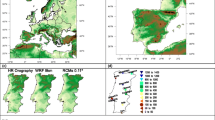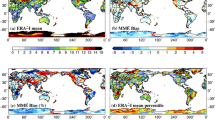Abstract
This study is oriented towards quantification of the skill addition by regional climate models (RCMs) in the parent general circulation models (GCMs) while simulating wind speed and wind potential with particular reference to the Indian offshore region. To arrive at a suitable reference dataset, the performance of wind outputs from three different reanalysis datasets is evaluated. The comparison across the RCMs and their corresponding parent GCMs is done on the basis of annual/seasonal wind statistics, intermodel bias, wind climatology, and classes of wind potential. It was observed that while the RCMs could simulate spatial variability of winds, well for certain subregions, they generally failed to replicate the overall spatial pattern, especially in monsoon and winter. Various causes of biases in RCMs were determined by assessing corresponding maps of wind vectors, surface temperature, and sea-level pressure. The results highlight the necessity to carefully assess the RCM-yielded winds before using them for sensitive applications such as coastal vulnerability and hazard assessment. A supplementary outcome of this study is in form of wind potential atlas, based on spatial distribution of wind classes. This could be beneficial in suitably identifying viable subregions for developing offshore wind farms by intercomparing both the RCM and GCM outcomes. It is encouraging that most of the RCMs and GCMs indicate that around 70% of the Indian offshore locations in monsoon would experience mean wind potential greater than 200 W/m2.











Similar content being viewed by others
References
Balog I, Ruti PM, Tobin I, Armenio V, Vautard R (2016) A numerical approach for planning offshore wind farms from regional to local scales over the Mediterranean. Renew Energy 85:395–405. https://doi.org/10.1016/j.renene.2015.06.038
Beniston M, Stephenson DB, Christensen OB, Ferro C, Frei C, Goyette S, Halsnaes K, Holt T, Jylhä K, Koffi B, Palutikof J, Schöll R, Semmler T, Woth K (2007) Future extreme events in European climate: an exploration of regional climate projections. Clim Chang 81(S1):71–95. https://doi.org/10.1007/s10584-006-9226-z
Carolin Mabel M, Fernandez E (2008) Analysis of wind power generation and prediction using ANN: a case study. Renew Energy 33(5):986–992. https://doi.org/10.1016/j.renene.2007.06.013
Christensen JH et al (2007) Regional climate projections. In: Solomon S et al (eds) Climate Change 2007: The Physical Science Basis. Contribution of Working Group I to the Fourth Assessment Report of the Intergovernmental Panel on Climate Change. Cambridge Univ. Press, Cambridge, U. K., pp 847–940
Cliff WC (1977) Effect of generalized wind characteristics on annual power estimates from wind turbine generators (No. PNL-2436). Battelle Pacific Northwest Labs., Richland
Crossley JF, Polcher J, Cox PM, Gedney N, Planton S (2000) Uncertainties linked to land-surface processes in climate change simulations. ClimDyn 16:949–961
Endris HS, Omondi P, Jain S, Lennard C, Hewitson B, Chang’a L et al (2013) Assessment of the performance of CORDEX regional climate models in simulating East African rainfall. J Clim 26(21):8453–8475. https://doi.org/10.1175/JCLI-D-12-00708.1
Gao X, Shi Y, Zhang D, Wu J, Giorgi F, Ji Z, Wang Y (2012) Uncertainties in monsoon precipitation projections over China: results from two high-resolution RCM simulations. Clim Res 52:213–226. https://doi.org/10.3354/cr01084
Giorgi F, Francisco R (2000) Uncertainties in regional climate change prediction: a regional analysis of ensemble simulations with the HADCM2 coupled AOGCM. ClimDyn 16:169–182
Glotter M, Elliott J, McInerney D, Best N, Foster I, Moyer EJ (2014) Evaluating the utility of dynamical downscaling in agricultural impacts projections. Proc Natl AcadSci USA 111(24):8776–8781. https://doi.org/10.1073/pnas.1314787111
Hofherr T, Kunz M (2010) Extreme wind climatology of winter storms in Germany. Clim Res 41:105–123. https://doi.org/10.3354/cr00844
International Energy Agency, IEA Wind, Annu Rep, 2011
IPCC Fifth Assessment Report: Climate Change, (2013), p. AR5.
Justus CG, Hargraves WR, Mikhail A (1976a) Reference wind speed distributions and height profiles for wind turbine design and performance evaluation applications. Technical Report, August
Justus CG, Hargraves WR, & Mikhail A (1976b) Reference wind speed distributions and height profiles for wind turbine design and performance evaluation applications.[USA] (No. ORO-5108-76/4). Georgia Inst. of Tech., Atlanta (USA). School of Aerospace Engineering
Kulkarni S, Deo MC, Ghosh S (2016) Evaluation of wind extremes and wind potential under changing climate for Indian offshore using ensemble of 10 GCMs. Ocean & Coastal Management 121:141–152. https://doi.org/10.1016/j.ocecoaman.2015.12.008
Kunz M, Mohr S, Rauthe M, Lux R, Kottmeier C (2010) Assessment of extreme wind speeds from regional climate models—part 1: estimation of return values and their evaluation. Nat Hazards Earth Syst Sci 10(4):907–922. https://doi.org/10.5194/nhess-10-907-2010
Leckebusch GC, Renggli D, Ulbrich U (2008) Development and application of an objective storm severity measure for the Northeast Atlantic Region. Meteorol Z 17(5):575–587. https://doi.org/10.1127/0941-2948/2008/0323
Leung, L. R., L. O. Mearns, F. Giorgi, and R. L. Wilby (2003), Regional climate research—needs and opportunities, Bull Am Meteorol Soc 84(1), 89–95, doi:https://doi.org/10.1175/BAMS-84-1-89., Regional Climate Research
Leung LR, Kuo YH, Tribbia J (2006) Research needs and directions of regional climate modeling using WRF and CCSM. Bull AmMeteorol Soc 87(12):1747–1751. https://doi.org/10.1175/BAMS-87-12-1747
Lileo, S., Petrik, O., 2000.Investigation on the use of NCEP/NCAR, MERRA and NCEP/ CFSR reanalysis data in wind resource analysis.sigma 1 (2).
Lucas-Picher P, Christensen JH, Saeed F, Kumar P, Asharaf S, Ahrens B, Wiltshire AJ, Jacob D, Hagemann S (2011) Can regional climate models represent the Indian monsoon? J Hydrometeorol 12(5):849–868. https://doi.org/10.1175/2011JHM1327.1
Neetu S, Shetye S, Chandramohan P (2006) Impact of sea breeze on wind-seas off Goa, west coast of India. J Earth System Sci 115(2):229–234. https://doi.org/10.1007/BF02702036
Nikulin G, Jones C, Giorgi F, Asrar G, Büchner M, Cerezo-Mota R et al (2012) Precipitation climatology in an ensemble of CORDEX-Africa regional climate simulations. J Clim 25(18):6057–6078. https://doi.org/10.1175/JCLI-D-11-00375.1
Pryor SC, Barthelmie RJ, Kjellström E (2005) Potential climate change impact on wind energy resources in northern Europe: analyses using a regional climate model. Clim Dyn 25(7–8):815–835. https://doi.org/10.1007/s00382-005-0072-x
Räisänen J, Hansson U, Ullerstig A, Döscher R, Graham LP, Jones C, Meier M, Samuelsson P, Willén U (2003) SMHI reports meteorology and climatology. No 101:61
Rockel B, Woth K (2007) Extremes of near-surface wind speed over Europe and their future changes as estimated from an ensemble of RCM simulations. Clim Chang 81(S1):267–280. https://doi.org/10.1007/s10584-006-9227-y
Sharp E, Dodds P, Barrett M, Spataru C (2015) Evaluating the accuracy of CFSR reanalysis hourly wind speed forecasts for the UK, using in situ measurements and geographical information. Renew Energy 77:527e538
Singh S, Ghosh S, Sahana AS, Vittal H, Karmakar S (2016) Do dynamic regional models add value to the global model projections of Indian monsoon? Clim Dyn:1–23
The Wind Energy Resource Atlas of the United States (Prepared for the U.S. Department of Energy, 2006
Torma C, Giorgi F, Coppola E (2015) Added value of regional climate modeling over areas characterized by complex terrain—precipitation over the Alps. J Geophys Res: Atmos 120(9):3957–3972. https://doi.org/10.1002/2014JD022781
Wang YQ, Leung LR, McGregor JL, Lee DK, Wang WC, Ding YH, Kimura F (2004) Regional climate modeling: progress, challenges, and prospects. J Meteorol Soc Jpn 82(6):1599–1628. https://doi.org/10.2151/jmsj.82.1599
Acknowledgments
This study has been carried out under the aegis of ADB TA-8652 IND: Climate-Resilient Coastal Protection and Management Project (CRCPMP). Authors acknowledge the World Climate Research Program’s Working Group on Coupled Modeling for producing and making available the model outputs. Authors acknowledge the modeling groups viz. the Centre for Climate Change Research (CCCR-IITM) for RegCM4 and partner institutions Rossby Centre, Swedish Meteorological and Hydrological Institute (SMHI), Sweden, for RCA4, for generating and disseminating the CORDEX South Asia multi-model dataset. The authors sincerely thank Prof. Manas Behera, IIT Bombay for his constructive suggestions and comments. Thanks are also due to Ms. Swati Singh and Ms. Piyali Choudhary who provided great help in downloading the CORDEX data.
Author information
Authors and Affiliations
Corresponding author
Rights and permissions
About this article
Cite this article
Kulkarni, S., Deo, M.C. & Ghosh, S. Performance of the CORDEX regional climate models in simulating offshore wind and wind potential. Theor Appl Climatol 135, 1449–1464 (2019). https://doi.org/10.1007/s00704-018-2401-0
Received:
Accepted:
Published:
Issue Date:
DOI: https://doi.org/10.1007/s00704-018-2401-0




